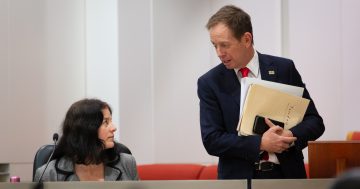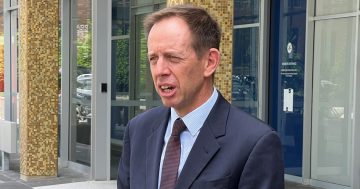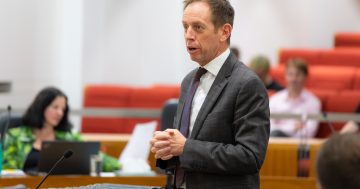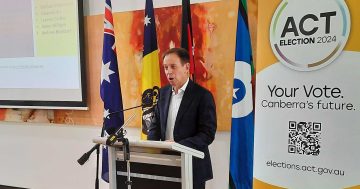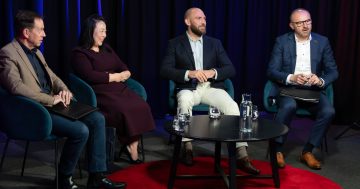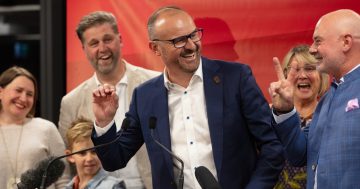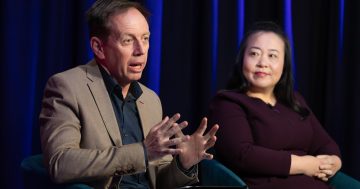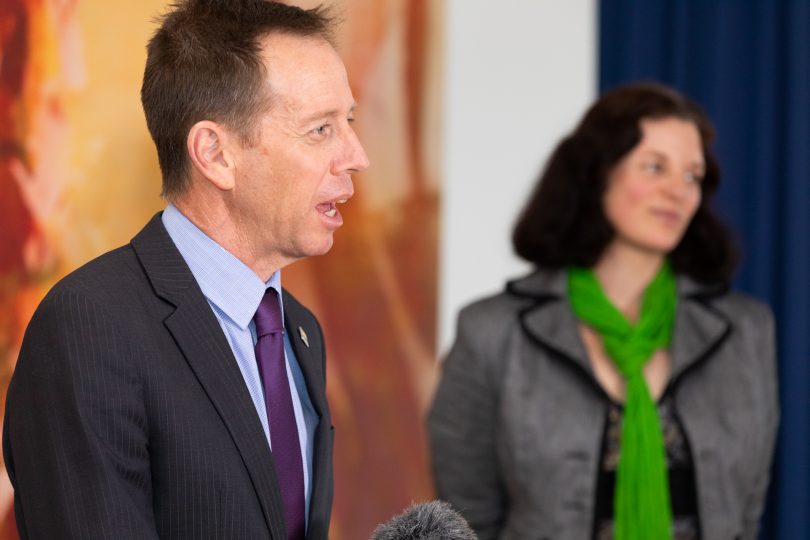
ACT Greens leader Shane Rattenbury and Member for Ginninderra Jo Clay. Photo: Michelle Kroll.
While the Labor Party was returned to government on October 17, the story of the night undoubtedly belonged to the ACT Greens who tripled their representation in the Assembly to a giddy six, one for each electorate and two in Kurrajong.
While psephologists will no doubt delve more deeply into the electoral entrails, it’s notable that the size of the swing to the Greens was roughly equivalent to that against the Liberals (at the final tally, a -2.9 per cent swing against the Liberals and a 3.2 per cent swing to the Greens).
Labor lost some ground (a swing against of 0.6 per cent), but that’s not where the movement of votes happened.
While the Belco Party were doubtless disruptors, they accrued just 5264 votes in Ginninderra. The majority of these preferences will have flowed towards Liberal Peter Cain, who unseated Attorney-General Gordon Ramsay.
The Canberra Progressives garnered 5446 votes across Kurrajong and Murrumbidgee, preferences likely to have flowed towards Labor and the Greens. A swing of 0.3 per cent across the ACT went towards “others”, including these two minor parties.
As an aside, it’s worth noting that if this swing to the Greens was, indeed, the end result of Josh Manuatu’s “highly professional campaign” for the Liberals, then he’s pulled off something quite remarkable.
Is there anywhere else in Australia where a jurisdiction-wide swing against the Liberals likely went Green? Mr Manuatu may have achieved a national first.
So what went right for the Greens?
On the ground, there was a lot of door knocking and personal conversations. Restricting their corflutes to private property probably didn’t influence votes, but it was clever signalling in an electorate where many find them immensely irritating.
There was a lot of policy, much of it focussing on the “roads, rates and rubbish”, issues beloved of Canberrans and little mention of the more extreme social measures that scare the horses elsewhere.
Instead, the focus was on issues like social housing, planning reform, local job packages and a deliberative democracy plan aimed straight at the enduring criticism that Labor doesn’t consult well. “Building a Better Normal” was a reassuring, optimistic and voter-friendly slogan in strange times.
These were the exact opposite of the Liberal tactics, which relied heavily on big picture promises, attention-grabbing campaign stunts like press calls at bakeries and a failure to account for how anything much would be funded.
Internally, Liberals say the belief they only had to stand still and wait for the public’s dislike of Andrew Barr to propel them over the line was damaging. Barr’s full quota came fast on election night, and if there was a protest vote against Labor, it likely went Green rather than Liberal.
Seasoned politicians believe there is no substitute for shoe leather in Canberra: political representatives aren’t remote figures in this jurisdiction. Voters expect them to be available and accessible, and candidates with a strong ground game, from Mark Parton to Tara Cheyne, do well.
But beyond the decisions around campaigning and policy, there’s likely something else at play.
Voters have had 12 years to watch Greens leader Shane Rattenbury in the Legislative Assembly, eight as a senior minister. Whether they agree with him or not, they’ve seen a competent politician at work, executing ministerial duties and reaching deals.
The Greens are a good fit for this generally progressive jurisdiction. It’s not hard to imagine centrist voters who dislike Labor but despair of the Liberals’ conservatism seeing the Greens as a reasonable choice.
Nationwide, this is exactly the balance that many other Greens have failed to strike. In NSW, there’s been an enduring split between more centrist Greens and the so-called ‘watermelons’ – green on the outside, red on the inside.
For years, the NSW party was riven by bitter ideological divisions, threats of legal action and accusations that they have been infiltrated by “destructive extreme left forces who will stop at nothing “, according to one of their own MPs.
Pitched battles have been fought in the Senate over accusations that Federal leaders like Richard di Natale and Adam Bandt have forgotten their environmental activist roots. It’s an unattractive proposition for voters seeking a plausible alternative.
The ACT Greens have plenty of work ahead of them to repay voters’ faith. Of the four Greens elected to the Assembly in 2008, only Rattenbury survived the 2012 election. It’s entirely possible that a good chunk of the new MLAs will go the same way in 2024.
Hardened observers would say this is about the best the Greens can do and government in their own right remains an elusive dream. But for now, their pragmatic community focus has served them well. How they shape the ACT’s government for the next four years should give progressives elsewhere pause for thought.












